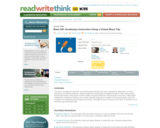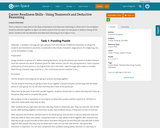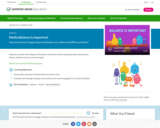![ArtsNow Learning: Moving Shapes [PDF]](https://openspace.infohio.org/static/newdesign/images/materials/default-thumbnail-index.png)
These activities will allow students to discover the concepts of geometry through shape exploration and the creation of choreographic sequences.
- Subject:
- Mathematics
- Material Type:
- Lesson Plan
- Provider:
- ArtsNow
- Date Added:
- 10/01/2022
![ArtsNow Learning: Moving Shapes [PDF]](https://openspace.infohio.org/static/newdesign/images/materials/default-thumbnail-index.png)
These activities will allow students to discover the concepts of geometry through shape exploration and the creation of choreographic sequences.

Students will be able to use a combination of drawing, dictating, or writing to narrate a single event and provide a reaction to what happened. This lesson centers around the book "The Song and Dance Man", a great Grandparents Day activity!

Students will sequence story events with the teacher and read an emergent reader in a guided setting. The chosen book, "Pilgrims and Wampanoag: Together They Were Better", has high use of sight words and high levels of picture support for the text, the kids can have a fair amount of success with this reader. Printables, pictures, and a video of a student reading the story are included in this lesson.

It is very important to build a class community where all students feel valued and safe. This activity will do just that and you will address the Common Core speaking and listening standards. Students will get to know each by discussing what they've brought in their "Getting to Know You Bag". A letter template and video of the lesson in action are included.

Descriptive details are used as students develop a guessing game poster for others to try and guess their chosen solid. Included in this detailed lesson plan are videos, samples of student work, a printable worksheet, an assessment checklist, and an extension activity.

If you really speak WELL, people will love to listen! In this lesson, students will practice routines to help them speak audibly and express thoughts, feelings, and ideas clearly. Teaching this in the first weeks of school sets expectations for communication throughout the year. Included are posters, videos, a speaking checklist, and an assessment sheet.

One important aspect of the common core is to prepare students to be able to participate in conversations and contribute accurate and relevant information. In this lesson, students listening skills will evolve as they translate verbal instructions into a tangible result. Included are pictures and videos of the lesson in action, and a kite template.

In this lesson students will write an informative sentence in response to listening to the story; "Mice squeak, We speak". Included in this lesson are examples of student work, videos of oral presentations, and puzzle pieces for new vocabulary.

Students will engage in a lesson that teaches them to associate certain expressions and words with specific feelings. Included are a senses powerpoint, a model of a graphic organizer, and a video and picture of the students engaged in the lesson.

Students will be able to describe familiar items and with prompting and support provide additional details by making Flubber. Making Flubber encourages students to engage in descriptive dialogue which helps develop the ability to provide precise details when recording observations and experiences.

Students will read an article and determine the author's point and identify the reasons the author gives to support his or her point. This lesson requires analysis by the students and a great deal of higher-order thinking as they evaluate the author's point and reasons. Includes guided practice work, a printable graphic organizer, and videos of the lesson in action.

Kindergarteners write for many purposes. In this lesson, kindergarteners learn that it is important to include recipe steps so the applesauce comes out just right!

3, 2, 1... Blast off! Students learn new vocabulary by taking a virtual field trip to the moon, read-alouds, creating a picture dictionary, and completing a final writing activity.

This is a lesson to help enforce the ideas of teamwork and deductive reasoning in school and in the workplace. Students will work together to figure out what a picture that has been cut into peices is without having all the peices. Students will use teamwork and deductive reasoning to try to figure it out.

Integrating speaking and listening builds a positive classroom community with less bullying, increased self-confidence, and greater independence, along with the ability to work with all students. This article gives ideas for projects or tasks to get students working together.

How do we find a happy balance between our online and offline activities? Students consider the feelings of themselves and others when making decisions about when, where, and how much to use technology. Approximately 25 mins.
LESSON OBJECTIVES: Know when and why to take breaks from device time. Consider the feelings of people around them, even when engaged in fun online activities.

[Free Registration/Login Required] This rubric helps with guiding and assessing K-2 students in giving a presentation. It is aligned with CCSS, but also can be used in non-CCSS settings. It is clear, concrete, and student-friendly, and can be used to guide students and assess their work, or to guide teacher thinking in creating their own assessment tools.

How do you say goodbye to technology when you don't want to? Whether it's watching TV or playing on a tablet, using tech can be super fun! Often, kids find it hard to transition from an online activity to an offline one. Teach your students a simple routine for how to manage those inevitable digital interruptions that are part of everyone's lives in the digital age. Approximately 30 mins.
LESSON OBJECTIVES: Learn why it's important to be aware and respectful of people while using devices. Learn the Pause, Breathe, Finish Up routine as a self-regulation strategy for transitioning from technology to face-to-face interactions.

In this segment, kids go to the library and try to get their friends to guess their favorite book titles without using any words, only drawings and actions. [1:33]

Contains plans for three lessons that teach about using e-mail as well as literary concepts like audience awareness. In addition to objectives and standards, this instructional plan contains links to sites used in the lessons as well as assessment and reflection activities.